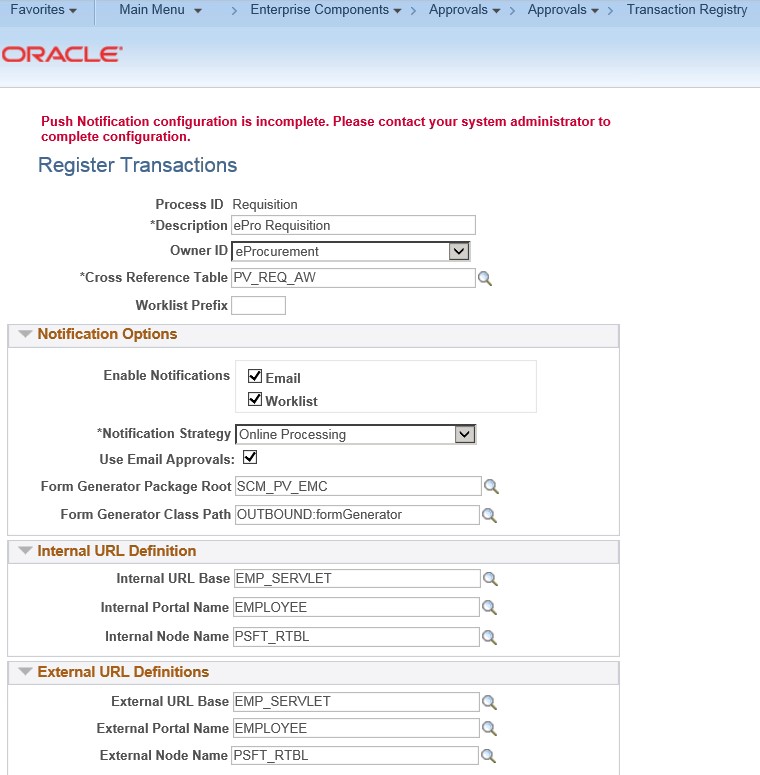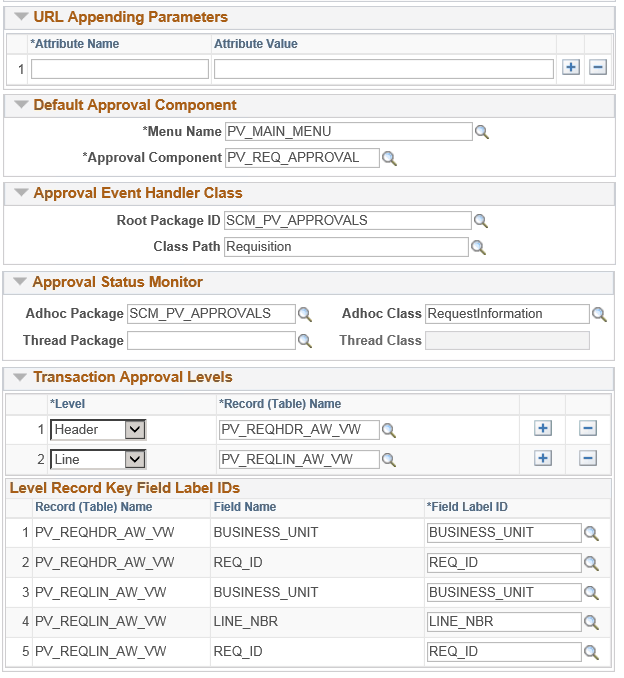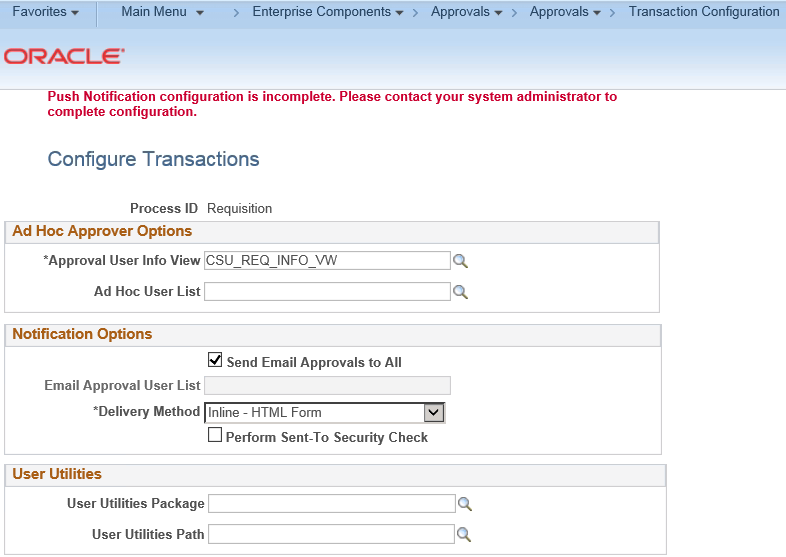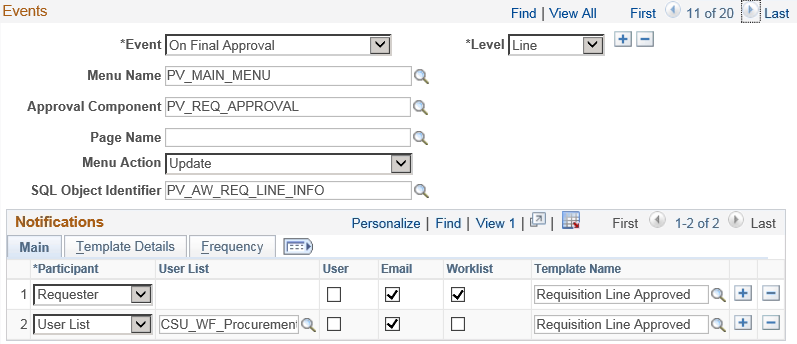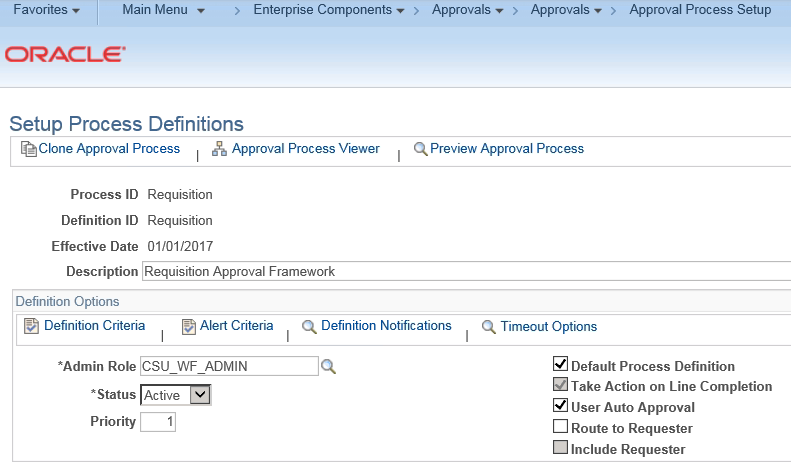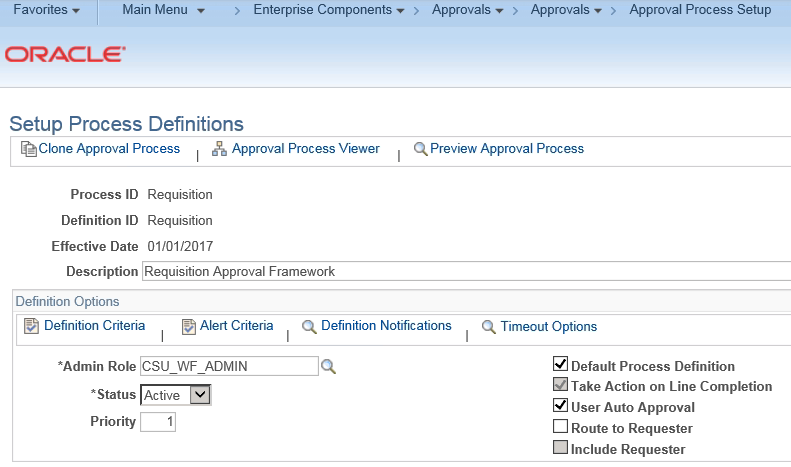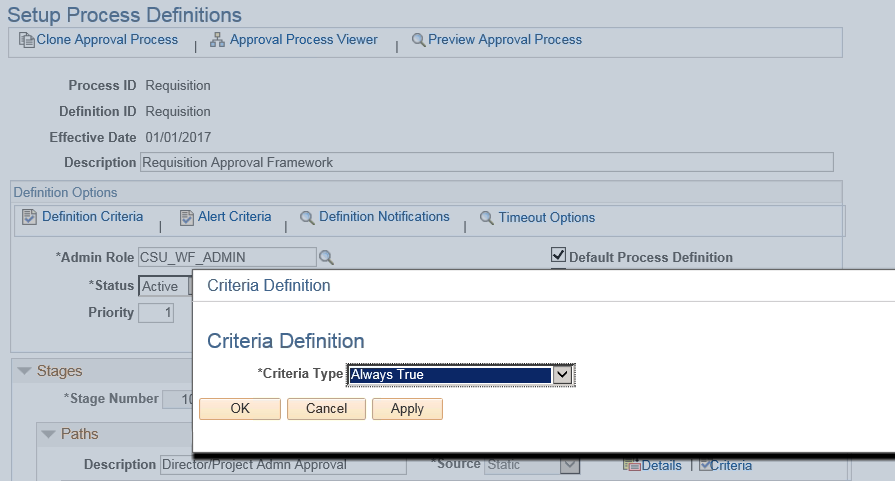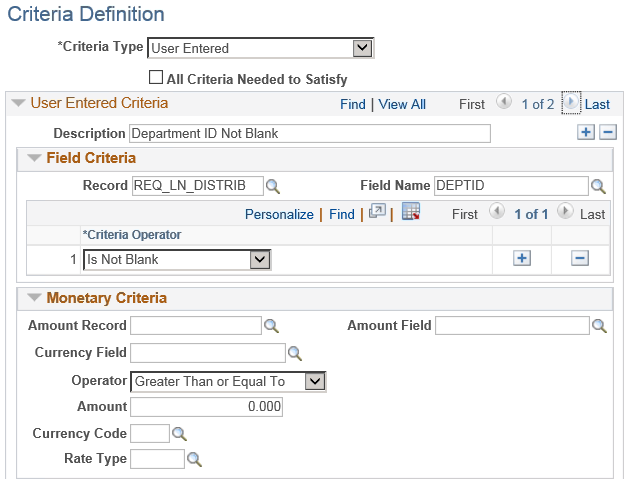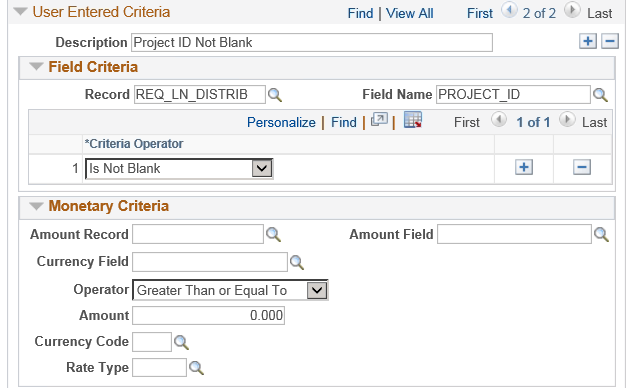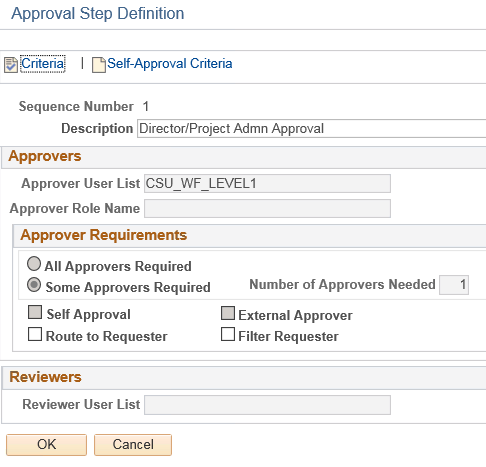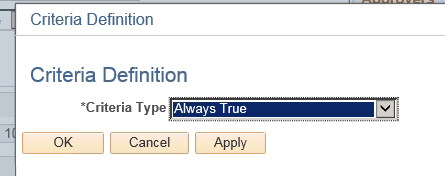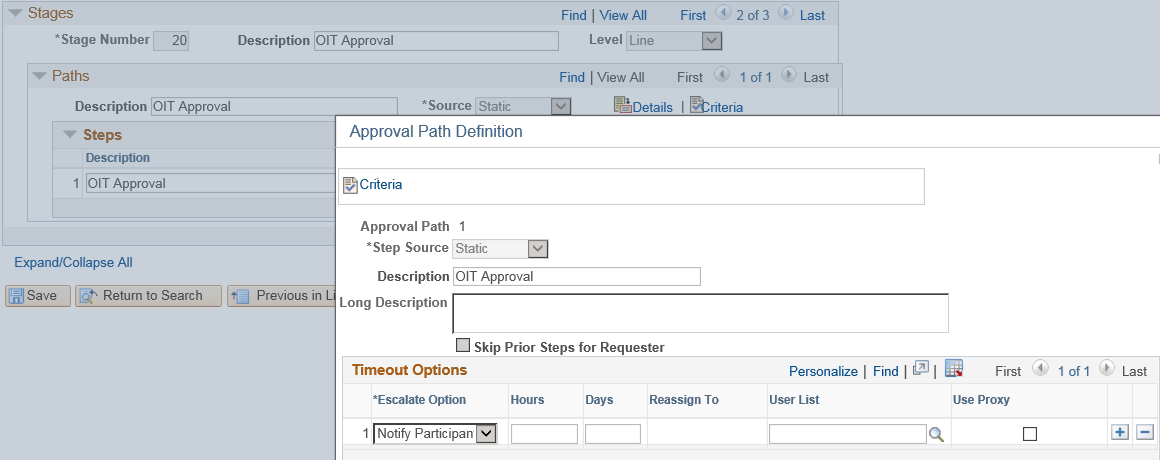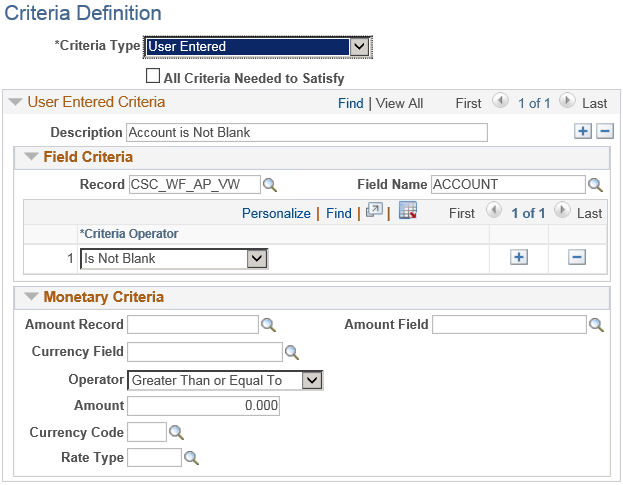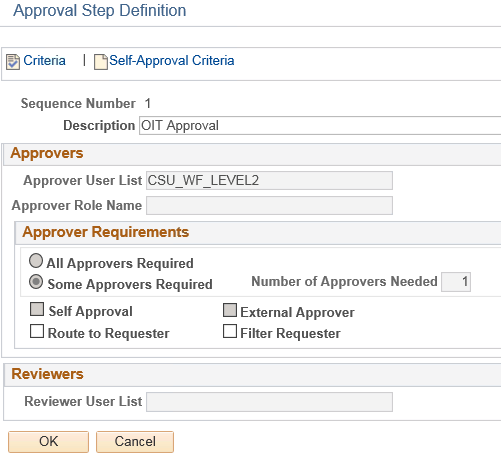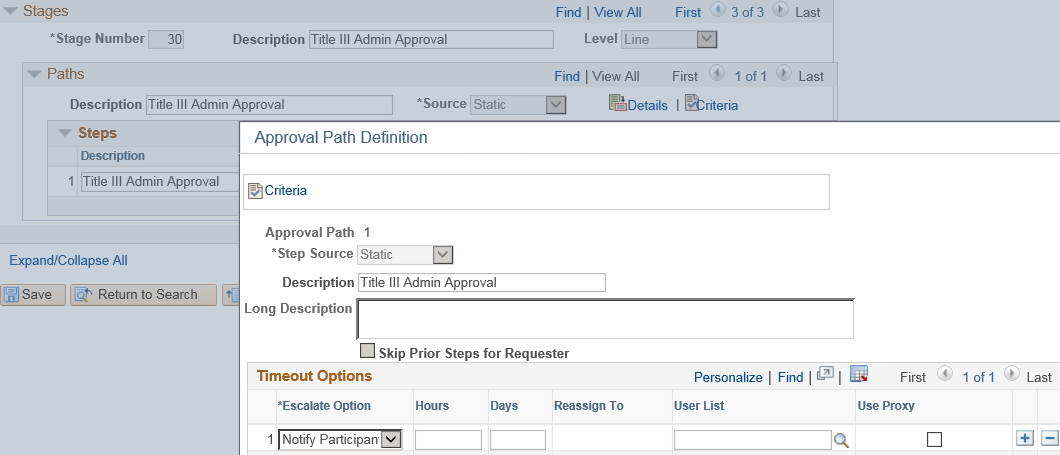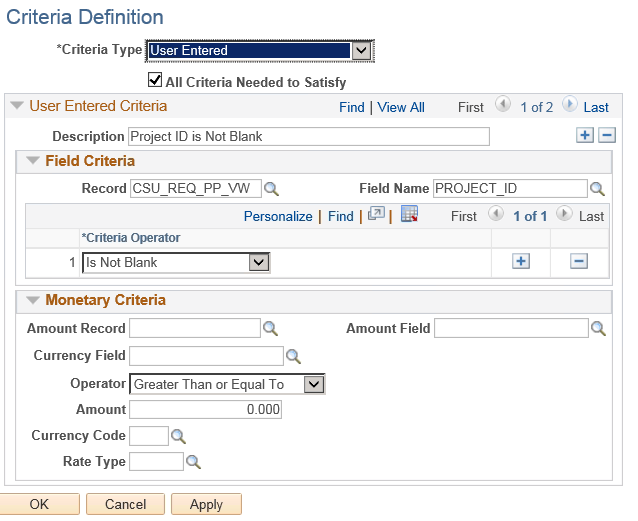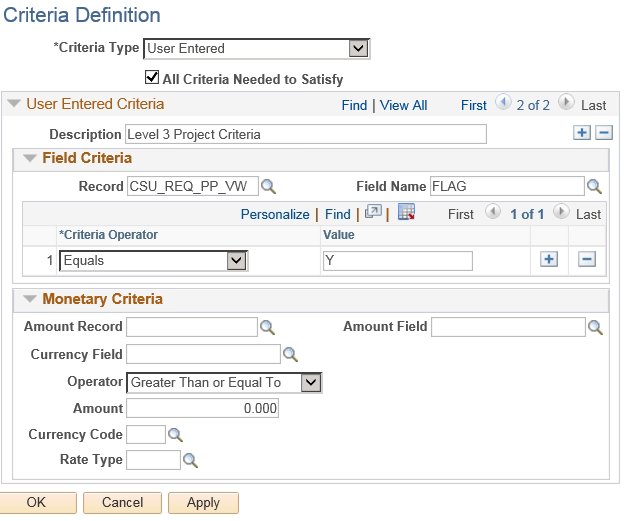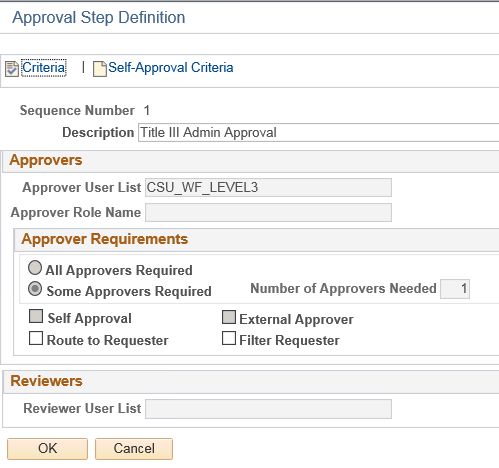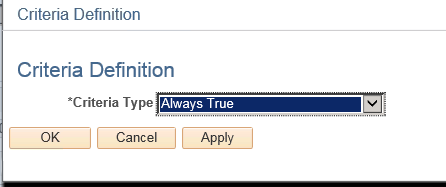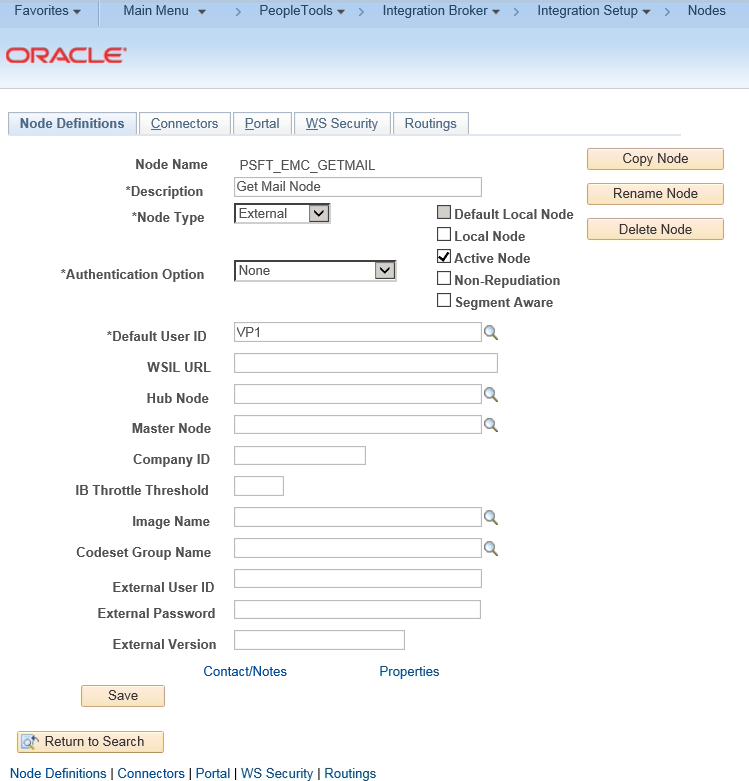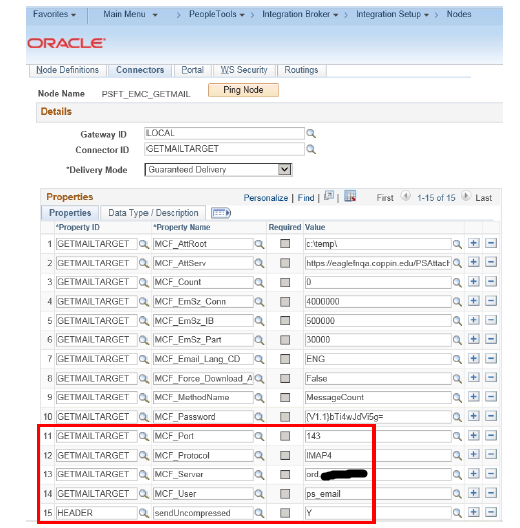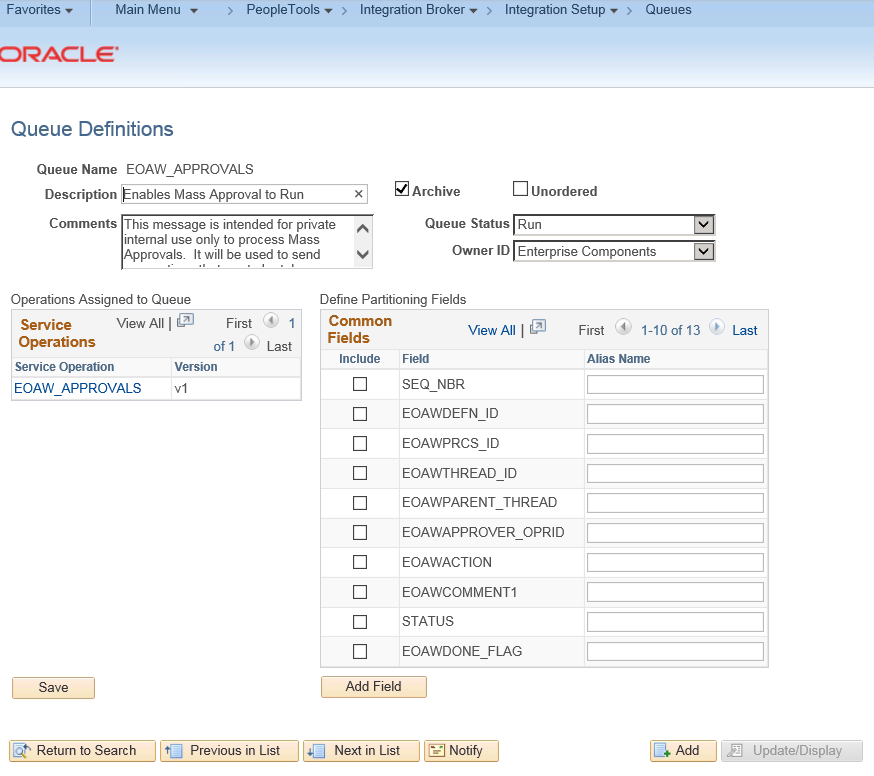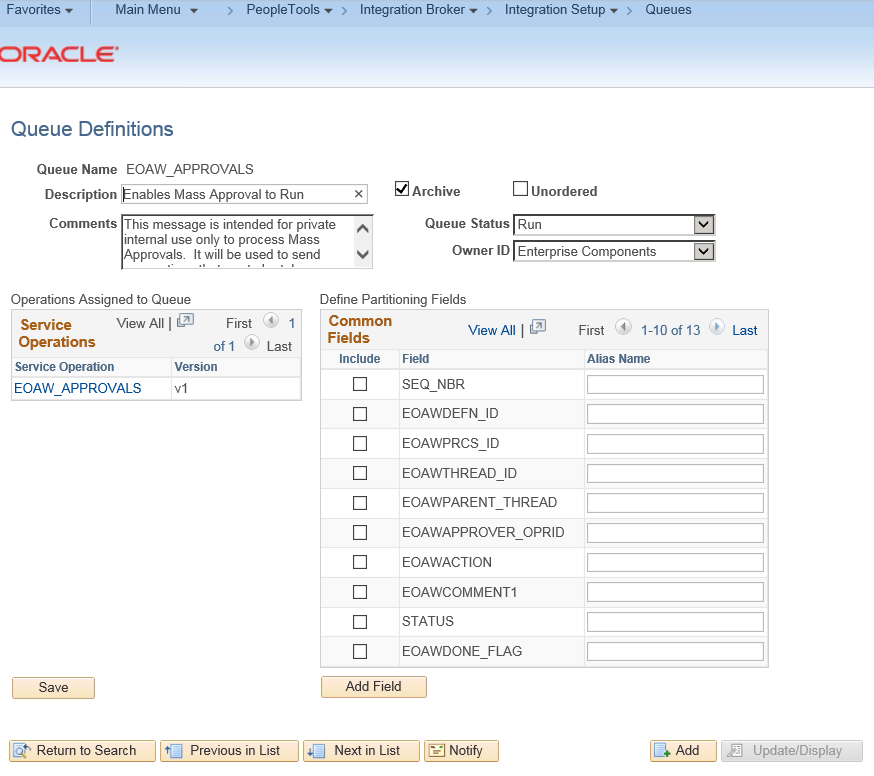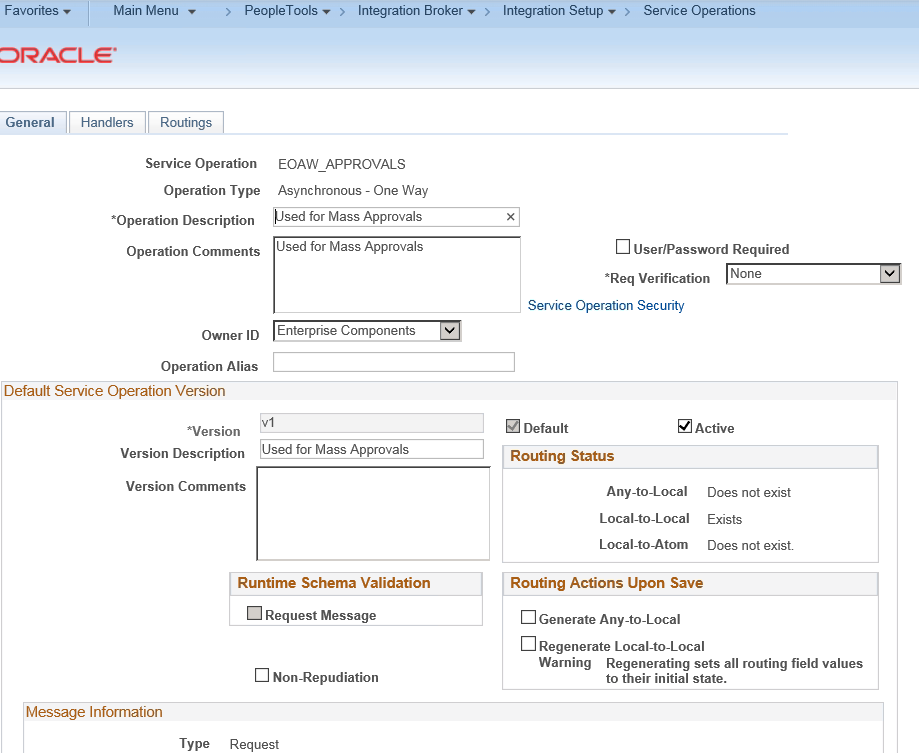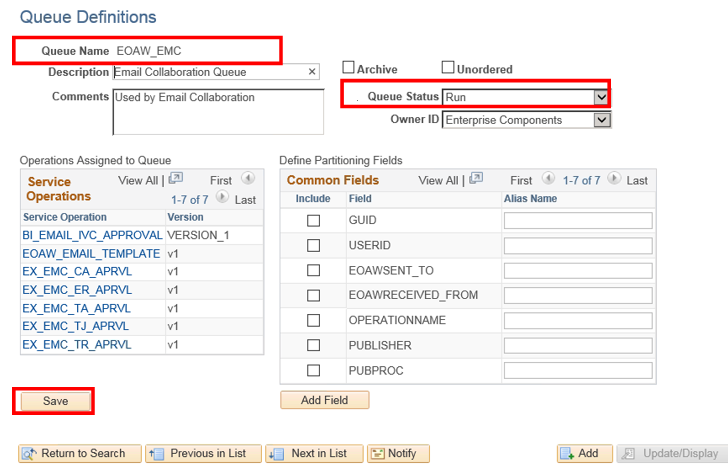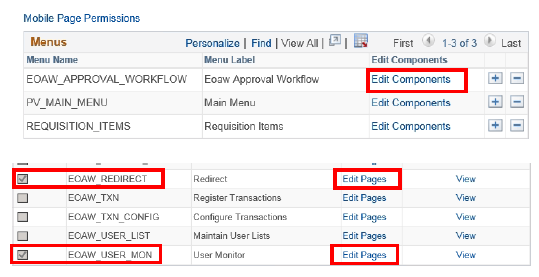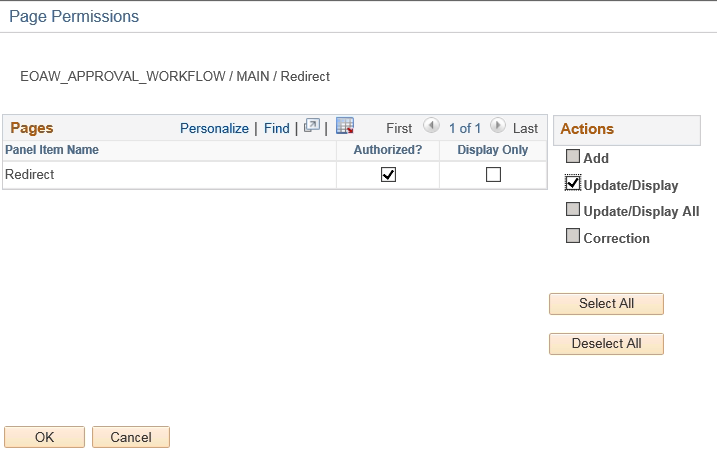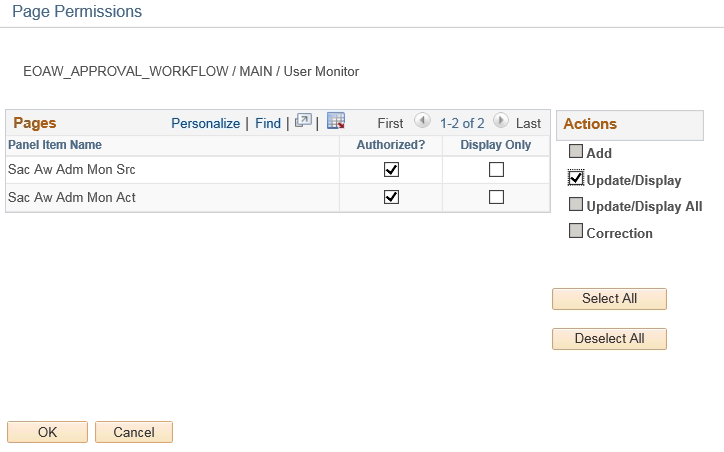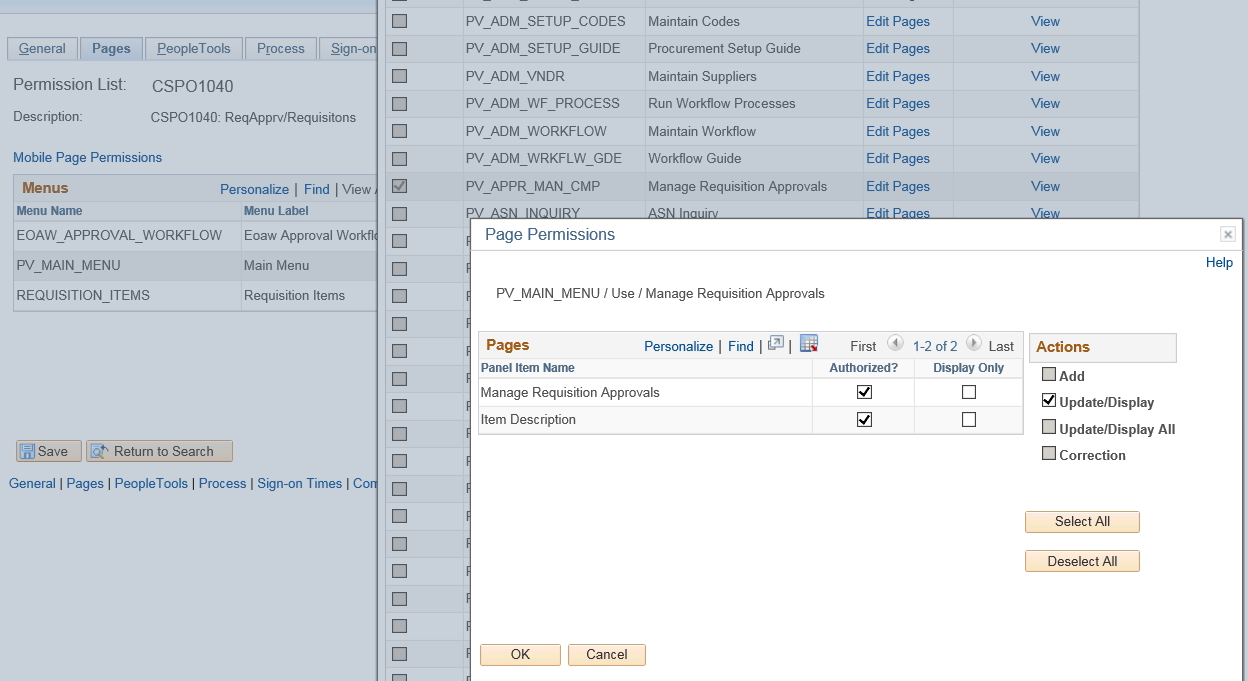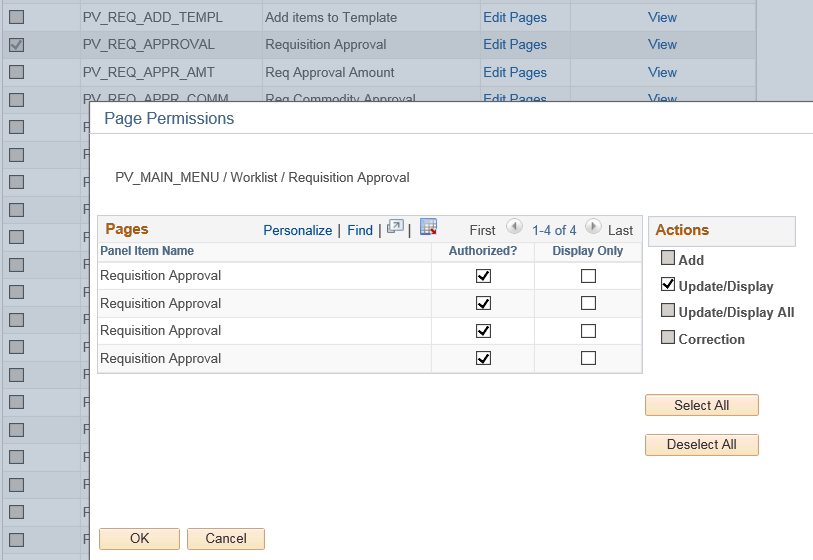Reviewing Financial Information in General Ledger
Navigation: Menu > General Ledger > Review Financial Information > Review Ledger Information
- The Ledger run control search page displays.
- If you have run this process or report in the past, select the Find an Existing Value tab to enter an existing Run Control ID and select the Search button. If this is the first time running this process or report, select the Add a New Value tab to create a new Run Control ID and select the Add button.
- NOTE: It is important to note that Run Control IDs cannot be deleted. Do not include spaces in your Run Control. We encourage the Run Control ID to have the same process naming convention but unique to the step; because of this, including your institution code and a short process description in the Run Control ID is recommended–e.g., 010_FINGL (College, Process).
- The Ledger Inquiry page displays. Enter the Ledger Criteria field values:
- Enter or look up Unit.
- Enter Ledger = LOCAL.
- Enter or look up Fiscal Year.
- Enter or look up From Period and To Period.
- Check the boxes Include Closing Adjustments and Only in Base Currency.
- In the Chartfield Criteria section, up to fourteen criteria can be used.
- Select the Save button to save this search.
- Select the Search button.

- The Ledger Summary page displays the criteria requested. Review results.
- Scroll to the bottom of the page to view the Posted Total Amount (cumulative total for the criteria requested).
- Select the side arrow icon next to the Ledger Criteria to expand to view requested criteria or collapse to hide.
- To return and update results, select the Inquiry Criteria link.

- From the main Ledger Summary page, select the Activity link of a specific row to drill into the Transaction Details.

- On the Transaction Details page displays. Review Ledger by Period and Chartfields and Journals content.
- Select the Journal ID link to further drill down to the original document. On the Journal Inquiry Details page, use the links in the Go To section to navigate to other Journal Inquiry pages.
- Optional to select the Transaction Criteria link to open a window displaying the ChartField Criteria.
- Select the Ledger Summary link to return to the main Ledger Summary page.

Set General Ledger User Preferences
Navigation: Set Up Financials/Supply Chain > Common Definitions > User Preferences > Define User Preferences
- The User Preferences search page is populated with the User ID with which you are currently signed in.
- Select the Search button.
- Use the User Preferences page to define user defaults for overall preferences and application-specific preferences, such as General Ledger.
- Select the General Ledger menu.
- Use the General Ledger page to define general ledger-specific profiles for users.
- Supply the default ledger, ledger group, and journal source to appear on pages for this user. Enter the most commonly-used values for the user in order to save keystrokes when entering data.
- Select the Journal Entry Options for this user. For example, the Date Code is displayed on journal lines only for users with the Enter Date Code Adjustments check box selected here – The Date Code is used to capture and report on multiple dates for single transactions, such as trade date and settlement date, in compliance with accounting standards.
- PeopleSoft General Ledger uses the Journal Post Defaults options whenever you post journals from the Journal Entry component – Deselecting an option here ensures that the deselected action is performed when this User ID posts a journal from the Journal Entry – Lines page.
- Select the Skip Open Item Reconciliation option to bypass open item reconciliation processing when the specified user posts an online journal entry. The user can reconcile the open items at a later time by using the Open Item Maintenance page – Deselect this check box to process open items during the online posting process – Select the Skip Open Item Reconciliation option.
- In the Online Journal Edit Defaults section, to Edit a previously edited journal, select the Re-Edit Previously Edited check the box.
- Select the Save button to save changes.

Uploading a Combo Code Spreadsheet
Navigation: Payroll for North America > CTC Custom > CTC Processes > COA Load for Combo Code
- The COA Load for Combo Code run control ID search page displays.
- If you have run this process or report in the past, select the Find an Existing Value tab to enter an existing Run Control ID and select the Search button. If this is the first time running this process or report, select the Add a New Value tab to create a new Run Control ID and select the Add button.
- NOTE: It is important to note that Run Control IDs cannot be deleted. Do not include spaces in your Run Control. We encourage the Run Control ID to have the same process naming convention but unique to the step; because of this, including your institution code and a short process description in the Run Control ID is recommended–e.g., WA020_COA_SPREADSHEET_LOAD (College, Process).
- The COA Load for Combo Code page displays. Select the Add Attachment icon to attach your file.
- Select Run.

Load Uploaded File into Load Combo Code Table
Navigation: Set Up HCM > Common Definitions > Chartfield Configuration > Load Combination Code Table
- The Load Combination Code Table run control ID page displays.
- If you have run this process or report in the past, select the Find an Existing Value tab to enter an existing Run Control ID and select the Search button. If this is the first time running this process or report, select the Add a New Value tab to create a new Run Control ID and select the Add button.
- NOTE: It is important to note that Run Control IDs cannot be deleted. Do not include spaces in your Run Control. We encourage the Run Control ID to have the same process naming convention but unique to the step; because of this, including your institution code and a short process description in the Run Control ID is recommended–e.g., WA020_COA_LOAD (College, Process).
- The Load Combination Code Table page displays.
- Enter As Of Date = “01/01/1901”.
- Always leave the Inactivate Accounts Not Downloaded checkbox unchecked – VERY important!
- Select Run.

Creatin
Creating a Manual Journal Entry
Navigation: General Ledger > Journals > Journal Entry > Create/Update Journal Entries
Header:
- The Create/Update Journal Entries search page displays. Enter existing search criteria or select Add a New Value tab to add a new value.
- If it did not automatically populate, enter or select the business unit in the Business Unit field.
- Select Add.
- The Create/Update Journal Entries page displays. The Header tab displays journal header information that uniquely identifies a journal, such as business unit, journal ID, and journal date. This page also contains options for setting, adjusting and reversing entries.
- Enter an appropriate description in the Long Description field, e.g. “Advertising Accrual.”
- Enter or select ‘ACTUALS’ in the Ledger Group field.
- Enter ‘ONL’ in the Source field. This is the code used for manual journal entries.
- Optional: Select the Save Journal Incomplete Status.
- If the journal entry is an accrual, then select the Reversal: Do Not Generate Reversal link to navigate to the Journal Entry Reversal page.

- The Journal Entry Reversal page displays. Use it to select the date that the journal entry will be reversed. Reversals are marked valid and ready to post when you create them; they don’t need to be edited.
- Select the radio button for the desired reversal date.
- Select OK.

- The Journal Entry Reversal page disappears. The updated Header page displays. If supporting documentation is required for the journal entry, select the Attachments link to navigate to the Journal Entry Attachments page where you can attach a file with supporting documentation. For example, you might want to attach a spreadsheet with the details on how the accrual entry was derived. The number in the parenthesis denotes how many documents you have attached.
- After the Header page is complete, select Lines.

- Enter or select the appropriate account in the Account field.
- Enter or select the appropriate operating unit in the Oper Unit field.
- Enter or select the appropriate fund in the Fund field.
- Enter or select the appropriate department in the Dept field.
- Enter or select the appropriate class in the Class field.
- Enter the journal entry amount in the Amount field.
- Enter or select the correct state purpose in the State Purpose field.
- Select Lines to Add and the + icon to add the off-setting item using the Copy Down ID functionality.

Note: All values just entered will be copied to the new line, with the exception of the Account and Amount. The Amount will be the amount needed to auto-balance the journal. As you change the Amount and add more lines, the Amount will automatically adjust to the amount necessary to balance the journal. You will need to provide an Account for each new line.
- Enter or select the appropriate account for the second line item in the Account field.
Note: The journal entry is balanced when the value in the Total Debits column is equal to the value in the Total Credits column. When you have a balanced journal, you may begin processing the journal directly from this page.
- Select Save.

- A Message window displays. Select OK to acknowledge the message. The message may say that the journal is saved with ‘T’ (incomplete) status (if that option was selected on the Header tab). “This journal cannot be edited or posted until you change its status to complete.”
The “T” (incomplete) status flag only prevents the journal from being processed by batch processing. The journal can still be edited, budget checked, and submitted for approval using the online options from the *Process list.

- The Message window disappears. The updated Lines tab displays. Note that your newly-created Journal ID displays.

- Use the Lines page to process the journal. Begin by verifying that the *Process box reads “Edit Journal”, then select Process.

Note: The Journal Status and Budget Status change to ‘V’ (Valid) after the journal is edited. You can only submit a journal for approval that is valid for both statuses.
Note: When you run the Edit Journal process, either on manual or system generated GL journal, the budget check is automatically run to validate the journal against a budget based on the type of account.
Note: Journal entries which require approval cannot be posted until approved through the ctcLink workflow approval process. Approval requirements vary by college district.
- Use the *Process drop-down list button to make a new selection.
- Select Submit Journal.
- Select Process.

Creating a Standard Journal Entry Model
Navigation: NavBar > Navigator > General Ledger > Journals > Journal Entry > Create/Update Journal Entries
- The Create/Update Journals Entries search page displays. Enter existing search criteria or select Add a New Value to create a new value.
- If it did not automatically populate, enter or select the business unit in the Business Unit field.
- Enter a journal ID for the standard SJE in the Journal ID field. Note: Because you are setting up the model for the standard journal entry, you do not want to leave ‘NEXT’ in this field.
- Select Add.

- The Create/Update Journal Entries page displays. The Header tab displays journal header information that uniquely identifies a journal, such as business unit, journal ID, and journal date. This page also contains options for setting, adjusting and reversing entries.
- Enter an appropriate description in the Long Description field, e.g. “Advertising Accrual.”
- Enter or select ‘ACTUALS’ in the Ledger Group field.
- Enter ‘ONL’ in the Source field. This is the code used for manual journal entries.
- Use the SJE Type drop-down button to select Model — Do Not Post.
- When the Header page is complete, select Lines.
Utilize the Long Description field to provide useful and detailed information that can help out with future reconciliations.

Entering Line Items
- The Lines page displays. Use it to record the transaction lines that comprise the journal.
Note: SBCTC requires the presence of a Business Unit (*Unit), Account, Dept, Fund, Class, and State Purpose for every journal entry. Additionally, grant and project related journal entries require a Project Bus Unit, Project Number, Activity, and Analysis Type. During processing of the journal entry, the system will use this information to check against the control budget.
- Enter or select the appropriate account in the Account field.
- Enter or select the appropriate operating unit in the Oper Unit field.
- Enter or select the appropriate fund in the Fund field.
- Enter or select the appropriate department in the Dept field.
- Enter or select the appropriate class in the Class field.
- Enter the journal entry amount in the Amount field.
- Enter or select the appropriate state purpose in the State Purpose field
- Select Insert Lines to add the off-setting item with the Copy Down ID functionality.

- Enter or select the appropriate account for the second line item in the Account field.
Note: The journal entry is balanced when the value in the Total Debits column is equal to the value in the Total Credits column. When you have a balanced journal, you may begin processing the journal directly from this page.
- Select Save.

- Next, edit the model journal. Select Process.

- Two confirmation message boxes appears in succession. Select OK to acknowledge that the journal has been saved; the message box disappears. Select OK to acknowledge that the journal that you have created is an SJE model journal. The message box disappears.


Note: The Journal Status is now ‘M’ (Model) . The normal journal that you use as a model should have a valid status. The system does not post Model SJEs to the general ledger, and they cannot be changed or deleted after you execute the edit process.

- Next, define the standard journal entry based on the model journal just created.
Defining a Standard Journal Based on the Model
Navigation: NavBar > Navigator > General Ledger > Journals > Standard Journals > Define Standard Journals
- The Define Standard Journals search page displays. Enter existing search criteria or select Add a New Value to create a new value.
- Enter a meaningful journal ID for the standard journal in the Standard Journal field.
- Select Add.

- The Define Standard Journals page displays. Use it to define the standard journal that becomes the high-level key for all journal entries generated using this definition.
- Enter a brief description of journal that you want to create in the Description field (this is the field at the very top of the screen to the right of the SJE ID field).
- Enter a meaningful description of the standard journals to be created in the Description field (this is the field in the SJE Detail section of the screen).
- Use the SJE Type drop-down button to select the SJE type. SBCTC will use ‘Recurring on a Schedule.’
- Use the Journal ID field to enter or select the ID of the model journal that you created earlier. This ID provides the system with information about the model that is linked to the standard journal.
- Enter or select the appropriate date that the model journal was created into the Journal Date field.
- Use the Schedule drop-down button to select the processing frequency for the SJE.
- Use the From Date and the To Date fields to define the time range of the SJE entries.
- If you want to add lead days to have the journal entry ready for creation each month, use the Journal Creation Lead Days field to enter the number of days in advance of the journal date that you want the standard journals to be ready for creation.
- Select Save.

- Finally, post to the General Ledger using the SJE.
Creating Standard Journals Postings
Navigation: NavBar > Navigator > General Ledger > Journals > Standard Journals > Create Standard Journals
- The Create Standard Journals run control ID search page displays.
- Enter an existing Run Control ID or use the Add a New Value tab on the Create Standard Journal page to add a new value.
- Enter a meaningful Run Control ID for the standard journal in the Run Control ID field.
- Select Add.

- The Create Standard Journals Request page displays. Use it to specify the parameters for running the SJE process.
- Use the Process Frequency drop-down button to select the processing frequency. SBCTC will use ‘Always.’
- Enter or select the appropriate unit in the Unit field.
- Use the From SJE and the To SJE fields to define the journal range of the SJE entries.
- Enter a brief description of the processing request in the Description field.
- SBCTC is utilizing budget commitment controls. Select the Recalculate Budget Date checkbox to create a standard journal entry with a budget recalculation.
- Select Run.

- The Process Scheduler Request page displays. Use it to enter or update parameters, such as server name and process output format.
- Use the Server Name drop-down button to select the appropriate processing server for the request.
- Select OK.

- The Process Scheduler Request page disappears. The updated Create Standard Journals Request page displays. Note the Process Instance number. Select Process Monitor, then refer to the Process Monitor QRG for instructions.

Journal Spreadsheet Template

- o utilize the Journal Upload process the following files must be present on your workstation:
- For Microsoft Excel 2007 (and subsequent versions)
- JRNL1_WS.xlsm – This is the journal workbook that you use to create and import journals.
- JRNLMCRO_WS.xlam – This is the Visual Basic code library and dialog control.
- For Microsoft Excel 2007 (and subsequent versions)
Note: Use the JRNL1_WS.xlsm file to enter your journals. You must set up Microsoft Excel to accept macros, by navigating to File > Options > Trust Center > Trust Center Settings > Macro Settings and selecting either Disable all macros with notification, or Enable all macros.
- Open the JRNL1_WS Excel file. The Spreadsheet Journal Import page will displays.
- If prompted, choose to Enable Macros.
- The control buttons on the Control page are grouped into three group boxes:
- General – Setup workbook defaults, configure ChartFields, and rearrange columns.
- Journal Sheet – Maintain the journal sheets in the workbook.
- Import Journals – Import the journal sheets from the workbook.
- The General group box enables you to define options and defaults for this workbook and to enter any notes or calculations concerning imports.
- Setup & Defaults – Select to set up access to the Define Options and Defaults dialog box. Use to set journal header defaults, message logging options, document sequencing options, online import controls, and so on. You can also access the ChartField Configuration dialog box from here.
- Notes – Select to access a scratch pad in the workbook. Use the scratch pad for instructions, calculations, notes, and so on.
- The Journal Sheets group box enables you to insert a new journal sheet; or edit, delete, or copy an existing journal sheet.
- New Sheet – Select to insert a new journal sheet. A workbook may contain as many journal sheets as needed, and each journal sheet may contain as many journals as desired.
- Edit Sheet – Select to edit one journal sheet in the workbook.
- Delete Sheet – Select to delete one or more journal sheets in the workbook.
- Copy Sheet – Select to copy one journal sheet to a new journal sheet saved under a new name.
- The Import Journals group box enables you to import one or more of the journal sheets and save journal sheets to a file.
- Import Now – Select to initiate online import of one or more journal sheets. The system imports only journals that are marked as import.
- Write to File – Select to save selected journal sheets to a text (txt) file. After saving one or more files, you must run the upload process to complete the text file upload process.

Setting Up Journal Spreadsheets
Before you start entering journals, you must specify the options, defaults, and settings for the journal sheets in your workbook. From the Spreadsheet Journal Import control page, select the Setup button to display the Define Options and Defaults dialog box.
- Establish the following Header Defaults:
- Business Unit – enter your Business unit
- Date – enter a default Journal date. The date can be overridden on the headers on the individual sheets.
- Ledger Group – enter ‘ACTUALS‘
- Source – enter ‘EXT‘
- User ID – enter your user ID for the journal header.
- Do not check Enable Multibook or AutoGen Lines
- Choose from one of the two Message Options radio button:
- Log Error Messages Only: The system logs import messages to JRNLLOG.xls only when errors occur.
- Log Successful and Error Messages: The system logs all import messages to JRNLLOG.xls regardless of the import process being successful (RECOMMENDED).
Note: If you would also like to show import messages online, select the Display Messages Online checkbox. Otherwise, errors go only to the message log JRNLLOG.xls.
- Do not select the Enable Document Sequencing checkbox or enter a Default Document Type.
- Complete the following fields for Online Import Control:
- Address – the address will already be populated with the correct information.
- User ID – Enter your logon user ID.
- After Successful Import –
- Change Import Status to ‘Do Not Import’: The system changes import status of journals that are imported successfully. This prevents reimport of the journals when you attempt to import them a second time.
- Keep Import Status as ‘Import’: Select this if you do not want the system to change import status so that you can reimport it later.
- You can override journal import status at the journal sheet level anytime.
- Skip If Journal Already Exits – Select this option and online load does not update already existing journals. The option is intended to prevent duplicate journals when a user is unaware that a journal has already been processed. This option is the default and is only applicable for online import using the Import Now functionality.
- A message is logged providing details of any journals skipped because they already exist in the system.
- If the option is not selected, online load updates already existing journals with valid journal data.
It is most common to use NEXT for the journal ID.
- Skip If Journal Has Error – Select this option and online load does not load invalid journals. This option is the default and is only applicable for online import using the Import Now functionality.
- A message is logged providing details of journals that have invalid data.
- If the option is not selected then the online load does not load either valid or invalid journals for that journal sheet. Online load then proceeds to the next journal sheet and loads all journals in the next journal sheet if all the journals in the next journal sheet are valid.
- Configure button – Use the ChartField Configuration page to access a ChartField Configuration dialog box, in which you can include, exclude, or rearrange columns, as well as alter field labels and column formats for a worksheet.

- Within the ChartField Configuration box, optional to format the Columns and control its appearance. You can alter the contents of your spreadsheet only one column at a time. The column that you intend to edit is highlighted.
- Select Column section selects the column:
- Left Yellow Arrow icon – moves the selected column (grayed out) field to the left.
- Right Yellow Arrow icon – moves the selected column (grayed out) field to the right.
- Column options to perform actions to the column:
- Insert down arrow icon – inserts column
- Right Arrow icon – shifts selected column to the right
- Left Arrow icon – shifts selected column to the left
- Width plus [+] or minus [-] icons – widen or narrows the selected column
- Select Exit button to close and save changes.
- Select Column section selects the column:

Note: The configuration dialog box prevents you from deleting or modifying certain system required fields.
- Within the Chartfield Configuration box, optional to specify details on the Field Format tab:
- Use the Field Format dialog box to control the content and format of the columns on your spreadsheet.
- Field Name– You must use a valid database field name from the Journal tables. If you misspell a field name or enter an invalid field name, you will not receive an error message until you attempt to import the journal sheet.
- Label– Enter the column label for the spreadsheet journal workbook. Optional to locally update.
- Format– Specify the cell format.
- Apply– You must select to save this format for the journal sheet.
- Select Exit button to close and save changes.
The Product field name is actually the Appropriation Index in ctcLink PeopleSoft. Do not change the Field Name but recommended to update the label name to ‘App Index’ or ‘AI’.

- Return to the Spreadsheet Journal Import control page by selecting the X in the upper right corner of the Chartfield Configuration page, then the Home icon on the sheet.
- Select the New Sheet button on the Spreadsheet Journal Import control page to access the New Journal Header page.
- Enter an appropriate name for the journal entry spreadsheet you want to create in the Journal Sheet Name field.
- Select OK.

Journal Import sheet functions.

- Upload the selected journal to PeopleSoft.
- Return to the Home sheet.

Journal Header Functions
- Header details.
- Add a new Journal. A sheet can contain more than one Journal. Each Header is associated with it’s corresponding Lines by the Sys ID.
- Select a Journal.
- Edit a Journal.
- Copy a Journal.
- Delete a Journal.
- Change Import Status.

- Select the “+” button in the Journal Header section to select the spreadsheet header for the spreadsheet journal you want to create.
- Verify the header information is correct.
- Update the Journal ID, if not using ‘NEXT‘.
- Entered the desired Journal Date.
- Enter a Description for the journal.
- Select the Reversal option.
- Select OK.
- Verify the header information is correct.

Journal Line Functions
- Add one Line.
- Delete one Line.
- Add multiple lines.
You can define multiple blank lines and then populate them with data from another spreadsheet.
- Delete multiple lines.
- Check decimal point precision.

- Select the “+” in the Journal Lines section to add the first line to the spreadsheet journal.

- Select the “paper with a plus icon” in the Journal Lines section to add multiple lines to the spreadsheet journal. The Insert Multiple Lines box will open. Enter the number of lines to add and select Insert.

- Select the “x” icon in the Journal Lines section to delete one line.

- Select the “paper with an x” icon in the Journal Lines section to delete multiple lines.

- Populate the journal line data using the Tab key or arrow keys to advance from one cell to the next.
- Continue to select the “+” in the Journal Lines section to add one additional line to the spreadsheet journal, or select the “+…” to add multiple lines. Use the checkboxes above the field names to choose which fields to copy down to the new row(s).
- Use the Check button to verify the Amount fields that you have entered contain the proper number of decimal points before you import the journal. The default number of decimal points is 2.
- Select Save in Excel to save the spreadsheet.
- Select Home to return to the Spreadsheet Journal Import control page.
PRO-TIP: Use the ‘Reference’ and ‘Description’ fields to enter in your comments about the specific line item or the entire journal description.

- Select Import Now icon located on the right side of the Journal Entry Sheet to access the Import Journals Now dialog box.
- Select the spreadsheet file for upload in the Select Sheet field.
- Enter your password in the Password field.
- Select OK to import the journal.

Optional to select Import Now functionality from the main Spreadsheet Journal Import screen.

- If the import is successful you will receive the following system message:

- If the import was not successful, the system message will contain a brief description of the error. Correct the sheet data and re-import.
- Next step would be to review/edit the Journal ID (i.e. 0000000635).
Uploading a Journal Spreadsheet as a Text File
- Before you can import a journal flat file, you must take your journal spreadsheet that was created using the Spreadsheet Import Tool, edit it, change the import status and save it. From the Spreadsheet Journal Import Control page (JRNL1_WS.xlsm file), select the Edit button.

- On the Edit Journal Sheet page, select your journal and select the OK button.

- The spreadsheet journal opens. Select the Change Import Status button.

- The Change Import Status window opens. Select the Import radio button and then select the OK button.

- Select the Save button in Excel to save the spreadsheet.
- Select the Home button to return to the Spreadsheet Journal Import control page.

- From the Spreadsheet Journal Import Control page, select the Write to File button.

- Use the Write Journals to File page to select the Excel file to write to a text file for external upload to ctcLink:
- Select the appropriate journal in the Select Sheet field.
- In the File Name field, the menu path defaults in the computer location to which the new file will be located once the file is written. Write over this portion of the string with the name of the new file that you want to import into ctcLink, i.e. the name of your journal (my new File name for the screen capture below looks like this: C: Users\SVenable\Documents\GLUpload.txt).
- Select the OK button.

Navigation: NavBar > Navigator > General Ledger > Journals > Import Journals > Spreadsheet Journals
- The Spreadsheet Journal Import run control ID search page displays.
- Select the Add a New Value tab.
- Select Add.

- The Spreadsheet Journal Import Request page displays.
- In the Process Request Parameters section, enter the file processing parameters.
- Leave the defaulted values as is for these fields:
- Number of Data Files
- Character Set
- If Journal Already Exists
- If Journal is Invalid
- In the Journal Processing Options section, select the Edit Journal(s) box.
- Select the Add button, navigate to the text file located on your computer and upload in order to attach. After this step is complete, the Attached File name appears on the Spreadsheet Journal Import Request page.
- Leave the defaulted values as is for these fields:
If you are re-using a run control, you will have to delete the current file before you can add a new file.
- Select Run.

- Use the Process Scheduler Request page to enter or update parameters, such as server name and process output format.
- Use the Server Name drop-down button to select the appropriate processing server for the request.
Note: You can leave the Server Name field blank.
- Select Journal Import with Edit then select OK.

Note: A Process Instance number appears. This number helps you identify the process you have run when you check its status.
- Select Process Monitor.

- Use the Process List page to view the status of submitted process requests.
Note: The process has finished successfully when the Run Status column indicates “Success” and the Distribution Status is “Posted”.
- Select the Details link for the GL_EXCL_JRNL process name.

- Select the View Log/Trace link to check for any errors.
Note: Once errors are addressed, the View Log/Trace log will read import successful and you can move onto the next step.

- Verify that the process completed and that the journal imported successfully.

Create a Journal Entry Using SpeedTypes
Navigation: General Ledger > Journals > Journal Entry > Create/Update Journal Entries
- Select the Add a New Value tab to add a new journal entry. Your local college Business Unit should auto-fill.
- Leave the Journal ID field as “NEXT”.
- Select the Add button.
- The Header page displays journal header information that uniquely identifies a journal, such as Business Unit, Journal ID, and Journal Date. This page also has options for setting, adjusting, and reversing entries.
- Enter the desired information into the Long Description field. Enter a valid value e.g. “Miscellaneous office expenses“. The more detail or information provided, will help further down the line when reconciling.
- Use the Ledger Group field to specify the ledger group to which you want to post the journal.
- Use the Source field to specify the option for entering and editing journals. Select the Source field and enter the desired information. Enter a valid value e.g. “ONL“.
- Select the Lines tab.
Use the Attachments link to add backup documentation.

- Select the SpeedType lookup icon.
- Select the SpeedType checkbox from the existing list.
- Select the OK button to populate the ChartString.
Within the SpeedType List window, find the existing SpeedType by using the SpeedType search box or click on the SpeedType column to sort

- Enter the line Amount.
- Mark the checkbox of the journal line to copy.
- Add the number of lines to add (it will copy the above ChartString onto new Journal lines).
- Select the plus icon [+].

- The selected number of lines will be added and the SpeedType ChartString will be copied down. Review or update the ChartFields as needed.
- For each added line, enter the Account and Amount.
- Select the Save button to save the journal and generate a Journal ID.
- A message window displays that the Journal ID is saved. Select the OK button.

- In the Process drop down arrow, select Edit Journal and then select the Process button.
- A Message will display asking if you would like to wait for confirmation that the Edit process has completed. Select the Yes button.

After editing, the Journal Status value is V (valid) and the Budget Status value is V (valid).
Depending upon your security roles or AWE, use the Process drop down menu to:
- Submit Journal for Approval.
- Submit & Post Journal.

Approving Journals
Navigation: FIN > Approvals Tile
- From the FIN Homepage, select the Approvals tile. The Pending Approvals page will display.

- On the Pending Approvals page, select Journal Entry in the Task (left) area. The Journal Entries that are pending approval will display.

- On the Pending Approvals page, check the box for the desired Journal Entry.
- Enter a relevant Comment.
- Select Approve in the upper right corner. The Mass Approve pagelet will display.

- On the Mass Approve pagelet, comments can still be edited.
- Select Submit. The Pending Approvals page will redisplay.

Viewing and Updating Journal Entries
Navigation: NavBar > Navigator > General Ledger > Journals > Journal Entry > Create/Update Journal Entries
- Select the Find an Existing Value tab.
- Select the Business Unit field.
- Select the Journal ID field.
- Select the Journal Header Status list.
- If you are not sure what the journal status is, select the blank value from the list. This way, the search returns the journal regardless of its header status – Select the (null) list item.
- Select the Search button – and select the desired journal to view.

- The Header page displays information that uniquely identifies a journal entry.
- You can add attachments to your journals to provide supporting documentation. The parenthetical number indicates the number of attachments for the journal. Currently, there are no attachments – Select the Attachments (0) link.

- Use the Journal Entry Attachments page to add supporting documents to the journal.
- When selected, the Show to Approver? check box enables journal approvers to see an attachment (if approval workflow is enabled). If you deselect this check box, journal approvers are not able to view the deselected attachments.
- The approver can access the enabled attachments and add new attachments from the Approval Attachments page (JRNL_APPR_ATT_SEC). Access this page from the Attachments link of the GL Journal Approval page (General Ledger, Journals, Journal Entry, Manage Journal Approval, Manage GL Journal Approval – Select the Journal ID link.) OR (Worklist, Worklist – Select the Attachments link).
- Select the Add Attachment button to add supporting documents to the journal entry – Select the Add Attachment button.

- Select the Browse button.
- Select any file that you want to attach to the journal.
- Select the 2018US001 list item.
- Select the Open button.

- Select the Upload button.
- Notice your file now appears in the Details group box in the File Name column.
- Select in the Description field.
- Add a meaningful description for your supporting document.
- Enter the desired information into the 2018US001 field. Enter a valid value e.g.,”US0012018 Expense Schedule“.
- Select the OK button.

- Notice that the number of attachments displays in the link. If you select the Attachments link again, you will see that the system details have been added for the attachment as well.
- Select the Save button.
- Select the OK button.
- Select the Attachments (1) menu.
- Select the OK button.

- Notice that the User, Name, and Date/Time Stamp were added once the journal was saved.
- Select the Lines tab.
- Use the Lines page to enter and review the general ledger transactions. Also request further processing from this page.
- Use the Process field to select a task to run.

- Choose from the following tasks:
- Budget Check Journal: enables you to check the journal lines for the control budget.
- Copy Journal: enables you to copy your journal to a new journal.
- Delete Journal: enables you to delete the current journal. There are two journal delete methods: Physical Delete and Logical Delete. You select the Journal Delete Method on the Installation Options – General Ledger page.
- Edit / Pre-Check: enables the journal to be edited and run through the Budget Processor. However, the Budget Processor will only check the journal but the funds will not be reserved. This option appears only when General Ledger is enabled for Budget Pre-Check within the Commitment Control Installation Options.
- Edit ChartField: enables you to check if the journal has any ChartField related errors.
- Edit Journal: enables you to modify the journal.
- Post Journal: enables you to post the journal.
- Print Journal: enables you to create the Journal Entry Detail report, GLX7501 (or GLX7502 for separate debit and credit), which is a BI Publisher printed copy of the journal.
- Refresh Journal: enables you to retrieve this journal from the database to the page again.
- Submit Journal: enables you to initiate journal approval through workflow processing.
- For this example, retain the default selection of Edit Journal.
- Select the Process button.
- Notice that the Journal Status has changed from N to V (from Needs Editing to Valid)

- On the Pending Approvals page, note the Journal Entry that was approved is no longer listed.

Common Combo Edit Rule Errors
Combo Error for fields Account/Class/Dept/Fund/Oper Unit/State Purpose in group ALL_REQ. This error message usually means someone has missed one of the required fields. Less common, would be a tree setup needs to be completed (by ERP) because there is a new account or fund. This tree set up on a new account/fund would require a ticket to ERP support .
Combo Error for fields Account/Fund/Approp in group APPROP1. This error message is when an appropriation is missing/needs to be added or does not match the allowable combination of appropriation in a fund. Either the fund or appropriation needs to be changed; or an appropriation needs to be added or removed.
Combo Error for fields Dept/Fund/Class in group BANK_CASH. This is now used for several 9XXXXX departments to limit the fund and class. This rule is INCLUSIVE not exclusive and lists what you can use with 9XXXXX departments. The user will have to change the chartstring or discuss this with the Accounting staff at the SBCTC Board.
Combo Error for fields Class/Fund/Account/Approp in group CLASS221.This error message occurs because it is Requiring the correct Appropriation Index for Local Capital fund expenditures with Class 221.
Combo Error for fields Fund/Account in group FND149ACCT. This error message occurs when the chartstring is using a revenue account that is not acceptable with the fund 149. The account must be changed or discussed with SBCTC Accounting staff.
Combo Error for fields Fund/Project in group FND_PRJ. This error message occurs when the Fund requires a project, or a project is used and it is a fund that does not allow a project. The chartstring must be corrected.
Combo Error for fields Approp/Fund/Class in group R15_AI. Appropriation R15 can only be used with fund 147. To fix either the fund or appropriation (or both) the user needs to edit the chartfield.
Correct Grant/Project Accounting Entries in Accounts Payable
Scenario: A Voucher has been created using an incorrect Chartfield string, and is posted and paid. All other information on the voucher is correct. To avoid making a manual General Ledger entry, which would result in General Ledger and Payables being out of sync, or unposting the voucher, correcting the voucher and then reposting the voucher and payment, we simply enter a Journal voucher in Account Payable. On the journal voucher, we reverse the amount to the incorrect Chartfields and add the amount to the correct Chartfields. This will keep the General Ledger and Payables in sync.
Example: Voucher 00004339 (BU WA220) has been entered incorrectly with project ID 0000001780, and is posted, paid and GL distributed. The project ID should be 0000001783. Therefore, to correct the project ID we will create Journal Voucher in AP module.
Navigation: NavBar > Navigator > Accounts Payable > Vouchers > Add/Update > Regular Entry > Add a New Value tab
In order to create a Journal Voucher, you must first know the Voucher ID and the Supplier associated with that Voucher.
- Business Unit: BU defaults to specific value for each user.
- Voucher ID: Defaults to NEXT. The system sequentially numbers the voucher. DO NOT CHANGE.
- Voucher Style: Select Journal Voucher.
- Supplier ID: Enter the Supplier ID that is identical to the original voucher to be corrected. Make sure Supplier location is correct.
- Invoice Number: Enter the invoice number as entered on the original voucher and add the suffix of JV.
- Invoice Date: Enter the same invoice date as entered on the original voucher.
- Select Add.

- The Invoice Information tab displays. It enables you to enter or view invoice information, including invoice header information, non-merchandise charges, and voucher line and distribution information. Use journal vouchers to correct accounting entries that have already been posted and paid. You do not change any of the amounts on a journal voucher.
- Use the Related Voucher field to enter the number of the voucher against which you need to create the journal voucher. Enter the Related Voucher ID. The field is optional, but it should be populated to maintain an audit trail and to be able to search for it using the Related Voucher field on the Add and Search page.

Note: Every Journal Voucher requires 4 Distribution Lines. Journal Vouchers are not “paid” but journal entries attached to a voucher. The Cash Lines need to be added in order to move the cash with the expense. For example:
- Expense Line: Reversal of original entry
- Cash Line: Off-set of reversal of original entry line
- Expense Line: New/corrected entry
- Cash Line: Off-set of new/corrected entry
- Line Amount: Enter if applicable. The total of journal lines must net to zero.
- In theDistrbution Line section:
- Enter the Distribution Line 1: Enter the first distribution line to reverse the accounting entry that was recorded incorrectly on the associated voucher.
- Distribution Line 2: Enter the second distribution line to reverse the accounting entry of the cash line that was recorded incorrectly on the associated voucher.
- Distribution Line 3: Enter the new or corrected expense line entry of the voucher.
- Distribution Line 4: Enter the cash line distribution to offset the amount of new distribution line.
- Select Save.
Note: The sum of all amounts on the Journal Voucher must be equal to zero. If an adjustment is needed in the amount of the Voucher, an Adjustment Voucher must be created.

- The Journal voucher will be budget checked, approved and posted however, no payment will be created since the voucher has a zero balance.
Note: The sum of all amounts on the Journal Vouchers must be equal to zero. If an adjustment is needed in the amount of the Voucher, an Adjustment Voucher must be created.
The journal voucher will be selected for Approval, budget checking and posting; however, no payments will be created since the voucher has a zero balance.
- Select Submit Approval (or if needed, please see how Submit Vouchers for Approval).

- Post the Voucher either through online or batch.
- Once it is posted, the Post Status will show as “Posted”.
- Also, note that the Journal generator process must be run in order to move the accounting entries in GL.

Modify the Journal Entry Template
Navigation: NavBar > Navigator > Set Up Financials/Supply Chain > Common Definitions > Journals > Entry Template
- Select the Template Type list – Journal Entry Templates can be defined for All Users, Primary Permisson Lists, or User IDs.
- Select a Template Type – Select the All list item.
- Select the Search button.

- Use the Journal Entry Template page to specify which columns appear on the journal entry Lines page.
- The Template ID field stores the different journal entry templates from which you can select to use when entering your journal entries.
- The fields that are selected on the Journal Entry Template – Show Journal Line Grid Columns region will appear on the journal entry Lines page.
- Use the Default column to designate the Template ID whose format will be used when you first access your journal entry Lines page.
- Select the SHORTCOM Template ID to be the default template for the All Users Template Type – Select the Default option.
- Only one template can be designated as the default template. Deselect the STANDARD template ID so that the SHORTCOM template is the only default template that is designated – Select the Default option.
- Tailor the template IDs to include the fields that you want to display on the journal entry Lines page. For the SHORTCOM template, which we designated as the default, we want to include the minimum number of fields that we most commonly use in journals. Deselect the Alt Acct field so that it does not appear for the default template, SHORTCOM – Select the Alt Acct option.
- Use the scrollbar to scroll over to display the other options.

- Deselect the Book Code option for the default template, SHORTCOM, so that the Book Code field does not display in your default journal – Select the Book Code option.
- Deselect the Budget Period option for the default template, SHORTCOM, so that the Budget Period field does not display in your default journals – Select the Budget Period option.
- Deselect the Scenario option for the default template, SHORTCOM, so that the Scenario field does not display in your default journal – Select the Scenario option.

- Select the Amount tab.
- Select the UOM option to display the Unit of Measure field on the journal entry Lines page. This enables you to enter a UOM along with a statistical amount that you enter on the Lines page. Select the UOM option for the STANDARD template ID – Select the UOM option.

- Select the Miscellaneous tab.
- The Miscellaneous tab includes various other fields that you can display on the journal entry Lines page to enter data such as budget date, value added tax, open item key, budget reference, and journal line description.
- The Open Item Key option is required only in the case of open item transactions, such as deposit accounts or employee draw accounts – Select the Open Item Key check box for our SHORTCOM default template – Select the Open Item Key option.

- The bottom half of the Journal Entry Template page is the Journal Line Copy Down section. This section allows you to designate the fields whose values you want to retain for the next line that you add in your journal entry – For example, in the SHORTCOM template, the Unit, Ledger and Account fields are designated to have their values copied down to the new line when you add the next line on your journal entry.

Generating Subsystem Journals
Navigation: NavBar > Navigator > General Ledger > Journals > Subsystem Journals > Generate Journals
- The Generate Journals run control ID search page displays. Enter an existing Run Control ID or select Add a New Valueto create a new run control ID.
- Enter a meaningful Run Control ID for the Subsystem Journals in the Run Control ID field.
- Select Add.

- The Generate Journals Request page displays. Use it to define options, such as journal processing options, process frequency, SetID, accounting definition name, application business unit, ledger group, and date options for processing.
- Select all of the following journal processing checkbox options:
- Edit – performs the standard Journal Edit process
- Budget Check performs budget checking
- Post – posts the journals that pass the Edit and Budget Checking processes
- Select the Always radio button in the Processing Frequency section.
- Enter or select the appropriate SetID for the subsystem journals in the SetID field. The default is WACTC and is never changed.
- Enter or select the appropriate Accounting Definition Name (for example, APDEFN, ARDEFN) for the subsystem journal.
- Enter or select the appropriate Business Unit for the journal. Leave blank to select all values.
- Enter or select the appropriate ledger group (ACTUALS) in the Ledger Group field. Leave blank to select all values.
- If a template is to be used, enter or select the appropriate template to use for the subsystem journal in the Template field. Leave blank to select all values.
- Use the From Date Option drop-down button to specify the date selection option. If the option selected is to “Specify Date”, then enter the appropriate date in the corresponding From Date field. In general, use “No From Date” to pick up all relevant transactions, up to and including the To Date, regardless of the accounting date. This ensures nothing gets left behind because of an old accounting date.
- Use the To Date Option drop-down button to specify the date selection option. If the option selected it to “Specify Date’, then enter the appropriate date in the corresponding To Date field. In general, use “End Date To Period” to pick up all transactions with an accounting date equal to or less than the last day of the current open period.
- Select Run.
- Select all of the following journal processing checkbox options:

The Process Scheduler Request page displays. Use it to enter or update parameters such as server name and process output format.
- Use the Server Name drop-down button to select the appropriate processing server for the request, if applicable. You can leave the Server Name field blank.
- Select the FS_JGEN process.
- Select OK.

The Process Scheduler Request page disappears. The updated Generate Journals Request page displays. Note the Process Instance number. Select Process Monitor. Refer to the Process Monitor QRG for instructions.

Specifying Closing Rules for Year-End Close
Navigation: NavBar > Navigator > General Ledger > Close Ledgers > Closing Rules
- The Closing Rules search page displays.
- Select Add a New Value.
- Enter SetID.
- Enter ‘MANUYE’ into the Closing Rule field.
- Choose the ‘Year End’ option from the Closing Type list item.
- Select Add.

- The Closing Options page displays. Use it to define the closing scope and other closing options.
- Use the Effective Date field to specify the date from which the closing rule is valid. The current system date is the default value but can be changed if needed. Enter the appropriate information into the Effective Date field.
- Use the Status field to specify the status as ‘Active’ or ‘Inactive’.
- Use the Description field to briefly describe the closing rule that will appear on pages and reports. Enter appropriate information into the Description field.
- Use the Ledger Template field to enter the ledger template associated with the ledger to be closed. This template determines the ChartFields that are listed in the selection fields for the closing rule. Only the ChartFields defined for the selected ledger template can be included in the closing rules.
- Use the ChartField to specify the Account ChartField required for year-end closing. For year-closing, all P/L accounts must be closed to retained earnings. All P/L accounts will close to the account specified here unless overridden on the Net Income/Retained Earnings page. When you select a ledger group on the Close Request page, the ledger group must be associated with the ledger template that you enter here.
- Choose the ‘Account’ option under the ChartField drop-down menu.
- Use the ChartField Value field to enter the retained earnings account value that will be used as a default. Enter appropriate information into the ChartField Value field.
- Select the (+) Add a Row icon.
- Choose ‘Department’ from the ChartField list.
- Use the Retain CFV option to have the system retain the ChartField value from the ledger. The Retain CFV option is not allowed if the ChartField is Account. If this check box is selected, then the ChartField Value field must be blank. If the check box is deselected, then you must specify a specific value for the ChartField. Select the Retain CFV checkbox.
- Select Year End Closing Options to access the year end close options. The link is available only for year-end closings.

- The Year End Close Options page displays. Use it to select year end close processing options.
- Select OK.

- The Year End Close Options window disappears.
- Select the Journal Options tab. Use the Journal Options page to define journal options for system-generated journals created during the close.
- Enter the appropriate information in to the Journal ID Mask field. Use the Journal ID Mask field to enter a prefix for naming closing journals. *Note – Journals are identified by a 10-character alphanumeric ID. The system automatically appends the prefix that you specify here to the journal IDs. Alternatively, the value NEXT causes the system to assign the next available journal ID number automatically, without including the mask. (This option makes it more difficult to identify the closing journals.) Reserve a unique mask value for closing to ensure that no other process creates identical journal IDs.
- Enter the appropriate information into the Source field. Use the Source field to identify the originating responsibility for the journal entries being created.
- If you use the Document Sequencing feature, use the Closing Doc Type field to select a predefined closing document type for the closing journals. Enter the appropriate information into the Closing Doc Type field.
- Use the OpenBal Doc Type field to select a predefined Open Balance Document Type for your journals. Enter appropriate information into the OpenBal Doc Type field.
- Select the Create Journal Entries option to create journal entries for year-end close transactions.
- Select Roll Forward Options.

- The Roll Forward Options page displays. It enables you to indicate whether or not to roll forward none, some, or all of your profit and loss accounts and zero balances. Normally, only balance sheet accounts are rolled forward.
- Select the Do Not Roll Forward Zero Bal option to prevent the system from creating balance-forward amounts (period 0) for accounts with a zero ending balance. Normally, only balance sheet accounts are rolled forward, and their balance forward amounts stored in period 0. Use the P/L to Roll Forward to Next Yr field to determine how P/L will be rolled forward. Options are:
- Do Not Roll Forward: Do not roll forward any amounts from prior year accounts with the Balance Forward field on the Account Type page set to the value “Not Carry Forward”.
- Partial Roll Forward 1 Year: For selected ChartFields Value Sets, closing rolls forward the amounts from the first period through 998 of the year being closed to period 0 of the new year.
- Partial Roll Forward Cumulative: For selected ChartField Value Sets, closing rolls forward amounts from periods 0, and periods 1 through 998 of the year being closed to period 0 of the new year.
- Roll Forward All 1 Year: Closing rolls forward all accounts with the Balance Forward field equal to “Not Carry Forward” balances from period 1 through 998 for the year being closed to period 0 of the new year.
- Roll Forward All Cumulative: Closing rolls forward all accounts with the Balance Forward field equal to “Not Carry Forward” balances for period 0, and 1 through 998 for the year being closed to period 0 of the new year.
- If you elect to roll forward in the P/L to Roll Forward to Next Yr field, use the ChartField Value Set field to select the P/L accounts that you want to roll forward.
- Select the + Add Row icon and select additional ChartField value sets to roll forward more than one ChartField value set.
- Select Save.
- Select Net Income/Retained Earnings.

- The Net Income/Retained Earnings page displays.
- You can perform year end close on either the Account ChartField or the Alternate Account ChartField. In addition, you can define a year end closing rule on the Alternate Account only. In this case, no Account ChartField is required for retained earnings, P/L ChartField value sets, or roll-forward ChartField value sets. Closing populates the Account ChartField with the default values for the particular Alternate Account ChartField. However, you can enter an Account ChartField to accompany the Alternate Account ChartField if you want.
- To perform a year end close by Alternate Account ChartField only, select ALTACCT in the Close by field. In the close sequence, you typically perform a currency translation from the local ledger to a reporting ledger. You then close and report the local ledger by Alternate Account ChartField. You can then close and report the translated reporting ledger by the Account ChartField.
- Select the Set Default Retained Earnings option to use the default retained earnings that you define on the Closing Options page. If not selected, you must use the Net Income/Retained Earnings page to define all accounts to be closed. If you do not select this option, no default retained earnings account exists for P/L accounts that may have inadvertently been omitted on the Net Income/Retained Earnings page. When you use the balance sheet indicator option at the installation level, this option is set to Off, and it is display-only.
- Select the Create Jrnl by RE Group option to have year-end close create separate journals for each P/L ChartField value set group and retained earnings pair; that is, one journal for one ChartField value group number. For example, to have a separate journal for each department, you might enter DEPTID in the ChartField value set criteria, as well as in the retained earnings ChartFields on the Net Income/Retained Earnings page and then select this option.
- Select the Close the G/L Open Periods option to close all open general ledger periods for the business-unit-and-ledger-group combination and year being closed. This prevents any additional journals from being entered for the year that is being closed.
- Select the Close Adjustment Periods option to close all open adjustment periods for the business-unit-and-ledger-group combination and year being closed.
- Select the Store P/L Reversal Entries option to store P/L offsets in period 999 (where the closing entries for all accounts are stored). If you select this option, the system inserts ledger rows for the entries made to period 999 to close revenue and expense accounts. You can access these amounts using the General Ledger inquiry pages. If this option is not selected, offsets are not stored in period 999. If you select period 999 for reports, the ledger will be out of balance.
- Select the Initialize DR/CR with Net Bal option to begin the year with net balances of debits and credits, instead of carrying forward separate balances for debits and credits. This option is available only if you have enabled separate debits/credits (DR/CR) on the database. When separate DR/CR is enabled, the period 999 entries for profit and loss accounts offset not only the net ending balances, but also the debit and credit ending balances. This option enables you to begin the year with net balances of debits/credits, instead of carrying forward separate balances for debits and credits. If selected, the debit or credit balances are initialized with the net period zero balance. If the net balance is positive, this amount is placed in the DR column for period 0; if the net balance is negative, this amount is placed in the CR column for period 0. If not selected, the system moves the ending debit balance and ending credit balance forward to become the beginning balances of the following year. The DR column in period 0 is the sum of DR through the previous year. The CR column in period 0 is the sum of CR through the previous year.
- Select the Close DR/CR with Net Balance option if you are using the separate debit/credit modification and want to net the separated debit and credit amounts during year end closing for the equity profit and loss accounts before posting a single net amount to period 999.
- Select the OK button.
- Select the Net Income/Retained Earnings tab. Use the Net Income/Retained Earnings page to identify the profit and loss (P/L) ChartField value sets, and the retained earnings ChartFields for the closing.
- Select the Close To Multiple Ret Earnings option to close to multiple retained earnings accounts. This option is required when the Book Code option, the Balance Sheet option, or the Off-Balance Sheet option is selected at installation. If deselected (year-end closings only), the system uses the default account for retained earnings defined on the Closing Options page. All P/L accounts will close to the default retained earnings account.
- Enter the appropriate information into the ChartField Value Set field.
- Select the Update/New link to access the Setup ChartField Value Sets page, where you can create or update a ChartField value set to use as P/L ChartField value set.
- Enter the appropriate information into the ChartField and ChartField Value fields in the Retained Earnings section.
- Select Save.

Specify Open Update Periods for Month-End/Soft Close
Navigation: NavBar > Navigator > Set Up Financials/Supply Chain > Business Unit Related > General Ledger > Open Periods > Open Period Update
- The Open Period Update search page displays.
- Enter ‘GL’ in PeopleSoft Product.
- Use the Look Up icon or enter the appropriate information in the Business Unit field.
- Use the Look Up icon or enter the appropriate information into the Ledger Group field.
- Select Search.

- The Open Period Update page displays.
- Update the From Year field for each Trans Type.
- Update the From Period field for each Trans Type.
- Update the To Year field for each Trans Type.
- Update the To Period field for each Trans Type.
- Select Save.

Specifying Closing Rules for Interim Close
Navigation: NavBar > Navigator > General Ledger > Close Ledgers > Closing Rules
- The Closing Rules search page displays.
- Select the Add a New Value tab.
- Enter SetID.
- Enter Closing Rule.
- Enter Closing Item = “Interim”.
- Select Add.

- The Closing Options tab displays.
- Enter Effective Date.
- Enter Status.
- Enter Description.
- Enter Ledger Template.
- Enter Scope:
- “Incremental Current Period”: Includes current period balance from period start date to the end of period date.
- “Incremental Year to Date”: Used for daily close, includes transactions that you have posted since the last closing process, up to the as of date entered on the Close Request page. The closing process marks the journals that it processes as Closed, and the journals are not processed in future runs.
- “Incremental Year to Curr Per”: Includes transactions starting with period 1, hat is, period 1 through the end of the current period.
- Enter Target Currency Option:
- “Base currency of Prim Ledger”: Uses the base currency of the primary ledger in the ledger group as entered on the Detail Ledger Group page. The ledger group is automatically entered on the Close Request page.
- “Business Unit Base Currency”: Uses the base currency of the business unit.
- “Retain currency”: Uses the source transaction’s currency.
- To retain the offset entry in the original currency, select the Currency Code ChartField on the Journal Options page, and select “Retain Value”.
- Enter Adjustment Period. You have the flexibility to include multiple adjustment periods or no adjustment periods when doing an interim close – Select the Adjustment Period list.
- Select the Net Income/Retained Earnings tab.

- The Net Income/Retained Earnings tab displays. Use it to identify the profit and loss (P/L) ChartField value sets and the retained earnings ChartFields for the closing.
- The Close to Multiple Ret Earnings option is selected and unavailable.
- Use the Closing Offset Options field to specify the offset options for interim closing. Options are:
- “Autofill Offset From First Row”: Copies from the offset defined in the first row down to any offsets that are not yet populated.
- “Fill Individual Offset”: Verifies whether an offset is entered for every ChartField group.
- “Retain All CF Value for Offset”: Closes to the same date and same detail account as the source transaction. If not selected, specify the ChartField and value for the offset using the fields in the Offset Chartfields group box. If you select this option, no audit trail exists – For this example, accept the default value.
- If your business practices require you to indicate second retained earnings account and its driver, you can select the Add a New Row icon to add another value. ChartField Value Group Number 1 can have one Retained Earnings account number for a given P/L ChartField Value Set, while Group 2 can have another Retained Earnings for another P/L ChartField Value Set.
- Use the ChartField Value Set field to select the ChartField value set for the P/L accounts to be closed. The system uses the values in these ChartField Value Sets to identify the P/L accounts that will close to the retained earnings account that you will enter in the Retained Earnings group box for the ChartField Value Group Number.
- Use the Retained Earnings section to identify the retained earnings account or target account, to which the P/L accounts will be closed.
- Use the ChartField field to specify the Account ChartField required for interim closing.
- Select the Account list item.
- Use the ChartField Value field to enter the retained earnings account value that will be used as a default. This option is required for the Account ChartField. If you perform interim closes using an offset to retained earnings, you must use the offset account as the target retained earnings fo the year end close.
- Enter the desired information into the ChartField Value field.
- For interim closings only, identify the ChartField and ChartField Value for the offset to the retained earnings entries.
- Select the Account list item.
- For interim closings only, the ChartField Value can be only the Account ChartField, or it can be a combination of ChartFields.
- Enter the desired information into the ChartField Value field.
- Select the Journal Options tab.

- The Journal Options tab displays. Use it to define journal options for system-generated journals created during the close. Also, use this page to specify whether you want to create journal entries for the close process.
- Enter Journal ID Mask.
- Enter Source.
- Enter Closing Doc Type.
- Enter Closing Journal Date Option.
- The selection of the Create Journal Entries option creates journal entries for the close transactions only. This option is automatically selected for Interim close as journal entries should always be created in the interim close process.
- For interim close only, select the Edit Journal(s) option to have the journals automatically undergo the edit process. If you do not select this option, the closing process designates the journals as No Status – Needs to be Edited.
- For interim closings only, select the Budget Check Journal(s) option to have the journals automatically checked against the Commitment Control budget for the business unit and account. To select this option, you must have the Commitment Control feature enabled for the ledger group, and you must have selected the Edit Journal(s) option.
- For interim closing only, select the Post Journal(s) option to have the journals automatically posted to the ledger. To select this option, you must have selected the Edit Journal(s) option and the Budget Check Journal(s) check box if the Commitment Control feature is enabled for the ledger.
- Select Save.

Processing Year-End Close
Navigation: NavBar > Navigator > General Ledger > Close Ledgers > Request Ledger Close
- The Request Ledger Close run control ID search page displays. It defaults to the Find an Existing Value tab. In this example, we’ll create a new run control ID.
- Select Add a New Value.
- Enter Run Control ID.
- Select Add.

- The Ledger Close Request page displays.
- Select Process Frequency.
- Use the Close Request Type field to specify whether you are running a Close or Undo process.
- Enter the appropriate information into the Business Unit for Prompting field.
- Select the Closing Group by using the Look Up tool.
- Enter the year to be closed into the Fiscal Year field.
- Use the Check only, Do not process option to perform validation checking during the close. The system will not calculate retained earnings or balance forward amounts. Select Check only, Do not process option.
- Enter the appropriate information into the Ledger Group field.
- Enter the specific ledger process into the Ledger field.
- Select As of Date in the Closing Date Option box to specify the date for the closing process.
- Use the Specify field to enter the closing As of Date for the closing process. Enter desired information into the Specify field.
- After the Closing Group information has been entered, the Rules to Execute link appears. Select Rules to Execute.

- The Closing Rules to Execute page appears. Here you can select or deselect individual closing rules within the closing process group (in sequence only) to include or exclude when running the closing process.
- Select OK.

- The Closing Rules to Execute page disappears.
- Use the Selections area to select the Business Units to Close. You can specify selected business units or you can use trees to identify which business units you want to close. If you select the Selected Detail Values option, you can enter a specific business unit value, or values, in the Business Unit to Close area. If you select the Detail-Selected Parents option, you can enter a Tree SetID, a Tree and a parent node Level of units to process for closing.
- Enter the appropriate information into the Select Value field under the Business Units to Close section.
- Select Run.

- The Process Scheduler Request page displays. Use it to enter or update parameters, such as server name and process output format. You must select a Server Name to identify the server on which the process will run. If you use the same Run Control ID for subsequent processes, the server name that you last used will default in this field.
- Select the PS/GL Yearend Ledger Close checkbox.
- Select OK.

- The Process Scheduler Request page disappears. The updated Ledger Close Request page displays. Note the Process Instance number.
- Select Process Monitor. Refer to the Process Monitor QRG for instructions.

- The Process List page displays.
- The Run Status may be Queued, Initiated or Processing. Select Refresh until the Run Status reads Success.
- After the Run Status field shows Success, you know that the closing check was successful and you can return to the Request Ledger Close page. Select Go back to Request Ledger Close.

- The Ledger Close request page displays.
- Because the check only process was successful, the year-end close needs to process now. Deselect the check box. Deselect Check only, Do not process option.
- Select Run, then OK on the Process Scheduler Request page.
- Select Process Monitor. Refer to the Process Monitor QRG for instructions.

- The Run Status may be Queued, Initiated or Processing. Select Refresh until the Run Status reads Success. After the status is Success, the year-end close process has been successful.



































